Lively Objects: Curating ‘Broken’ Electronic Art
Walter Benjamin states that a thing’s obsolescence is determined by the moment in which the object becomes passé. Similarly, in his analysis of the “broken tool”, Heidegger claims that a thing becomes obsolete when it ceases to perform its intended function, becoming a different type of object. So what does this mean in relationship to new media art? An ever growing discipline that produces works of art that often have an expiration date. A hardware platform may become obsolete and software is lost, a robotic object may break and an antiquated part is no longer available. What can be done when a new media art object doesn’t work?
Norman White’s Facing Out Laying Low, 1977, highlights this kind of transition from usefulness to a state of crisis or liminality in the life of the medium. The work was initially intended as a motion capture robot that would follow the viewer as they moved around the space of a gallery and interact with them through sound responses. But what happens when a robot breaks? Can it still be a work of art? Should it still be displayed?
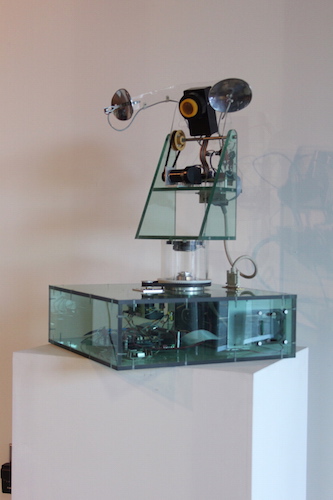
Martin Heidegger’s ‘Tool Theory’, Bill Brown’s ‘Thing Theory’ and the development of media-archeology, which is the study of media history through material culture as an emergent form of object-oriented archeology, may provide a theoretical framework for curatorial practice in relation to ephemeral and obsolete electronic and new media art. The concepts employed when referring to new media and electronic art objects in this text stem from these frameworks and presuppose that the art object has agency and an ephemerality, which also suggests that electronic and new media art objects can have ‘lives’.
The use of words like revival, postmortem, living, resurrection and other such terms associated with human mortality reflect the possibility of formulating an ontology of things that views non-human entities as living experiencing beings as well as agents. Heidegger’s tool-analysis theorizes the shifting experiences of functioning and obsolete or broken objects. Tool-theory can be used as a method for the treatment of obsolete electronic and new media art in the space of the gallery. Heidegger claims that the object world, which he consolidates under the term “tool” is experienced according to three features: 1. its readiness-to-hand, occurs during an average experience of the functioning object, 2. presence-at-hand which occurs when one becomes aware of and questions the object and 3. unreadiness-to-hand which occurs when an object breaks or becomes obsolete.
The third Heideggerian experience of unreadiness-to-hand will be the focus of this article and an exploration into curating the obsolete work of new media or electronic art. An object that is unready-at-hand exists in a liminal space that allows an object to appear as itself without being fully withdrawn into the users unconscious, as opposed to the ready-at-hand object.
Bill Brown’s Thing Theory expands on Heidegger’s pragmatic tool analysis to consider the distinction between an object and a thing and how this distinction can relate to a work of art. Brown proposes Claes Oldenburg’s Typewriter Eraser, as a classic example of a work of art that plays with the distinction between object and thing. The Typewriter Eraser, 1999, recalls Heidegger’s broken tool due to the typewriter’s obsolescence. Oldenburg’s Typewriter Eraser draws attention to contemporary culture’s reliance on quick cycles of imposed obsolescence, and the ephemerality of objects. The broken or obsolete thing just as with the ephemeral or dying object has the ability to exert control over the human subject by making them aware of their own mortality and human’s ephemerality.
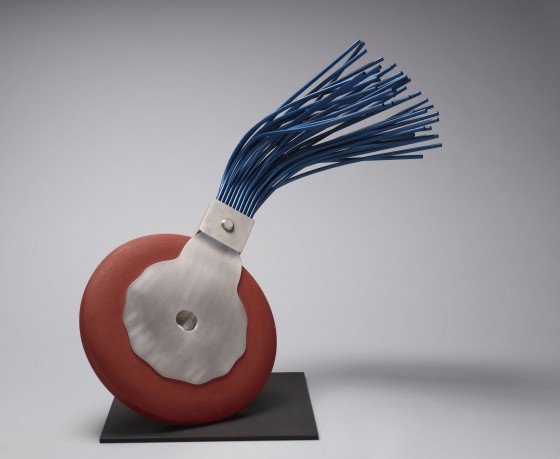
According to Walter Benjamin the distinction between the function of an object and our desire for it becomes clear only after it becomes obsolete. Therefore the viewer’s interaction with the art object can be informed and complicated through the object’s obsolescence. By re-using obsolete art the curator is able to create a new and original understanding of the work. Influenc(Ed.) Machines which featured the work of OCAD University alumni, as well as present and past faculty included two works of obsolete electronic art that were repositioned, or resurrected, as new entities that could speak in new ways to the viewer. The theme of Influenc(Ed.) Machines, inspired by the research and curatorial practice of Dr. Caroline Langill and Dr. Lizzie Muller and their use of the term ‘Lively Objects’, was the reciprocal relationships that can occur between the human and the machine, as well as the humanistic qualities often present in electronic and new media art.
Doug Back and Norman White’s Telephonic Arm Wrestling, 1986, was included in the exhibition as broken parts of the initial work, as it presently exists only in concept, documentation and artifacts of the original work. The work was a telecommunications project and collaboration between Doug Back and Norman White. The machine allowed subjects in two different locations to arm-wrestle using motorized force-transmitting systems connected by a telephone data link. Telephonic Arm Wrestling was first successfully exhibited in 1986 during a link-up between the Canadian Cultural Centre, Paris, and the Artculture Resource Centre, Toronto. The work was more of a spectacle or performance than a fine art or sculptural piece as it was shown in Influenc(Ed.) Machines. The interactive machine informed a cyborg dialogue a year before the film Robocop was released in 1987 predicting the merger of human and machine in a pop-culture outlet. The machine was created on a budget, forcing Back and White to scavenge and innovate before cyborg technologies had become part of a common culture. The artists dealt with a lack of available resources and thus there is a revolutionary quality to what they were able to accomplish with little materials, money or support from any institutions, who, at the time, did not consider technology as art.
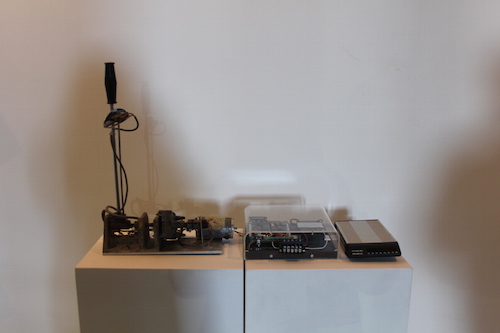
Today, the remaining parts of Telephonic Arm Wrestling recall an archeological discourse for new media technologies, as well as the history of, and the development of such practices as art. The fragments of the original work were exhibited in Influenc(Ed.) Machines on a white plinth isolated in the space of the gallery. Presently the work reminds the viewer of a history of technology and the present lack in touch transmission and physical connection over virtual interaction. The obsolete work makes the viewer aware of the potential for such technology considering the fact that these artists were developing such a device in 1986. This makes us conscious of an alternative trajectory media history could have taken if different paths had been pursued. Our culture has valued technology that appears to the visual senses, transmitting text and images virtually, rather than a focus on the transmissions of touch. Telephonic Arm Wrestling’s display as an obsolete object gives the work agency once again by provoking questions for the viewer in regards to why some technologies live and advance while others are wiped out in their evolution.
Norman White’s Facing Out Laying Low was the second obsolete work in Influenc(Ed.) Machines. Facing Out Laying Low is a microcomputer-controlled, interactive robot. The robot, before becoming obsolete, would have once surveyed its surroundings from a fixed point, and responded to activity it found engaging with a variety of audio responses, referencing Stanley Kubrick’s intelligent computer HAL from 2001: A Space Odyssey and making the viewer aware of the frightening possibilities of Artificial Intelligence. White’s robot would have eventually become less interested in the human subject and would shut down or move on to a new subject. The robot is a metaphor for the quest of possessing the newest technology and the systematic imposition of obsolescence on technological artifacts in contemporary culture. The former function of the robot was to remind the viewer how we rapidly become tired of old technologies, which only hold our attention and admiration for a brief moment in time. The exhibition of Facing Out Laying Low ‘postmortem’ further emphasized the work’s initial intention to address the experience of obsolescence.
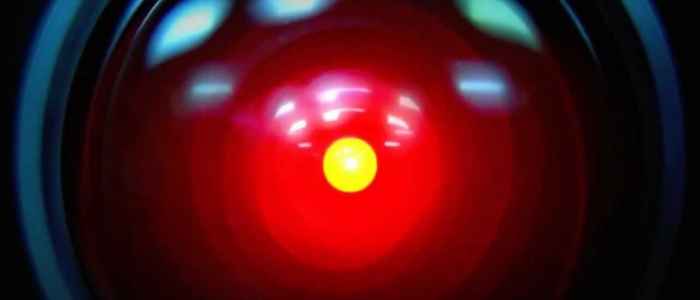
The contrast between function and non-function can create new and original meaning for the work. Facing Out Laying Low as a living smart robot was judgmental and easily bored by humans. Now that the robot no longer functions the roles are reversed in the human/object relationship and the once object agent, the robot, is now helpless and at the mercy and judgment of the human. The robot has itself become a victim of the system it was created to critique. The work suggests the possibilities of robotics and A.I. and the relationship between human and machine calling into question what or whom will become obsolete. Showing Facing Out Laying Low in the exhibition Influenc(Ed.) Machines was a conscious choice made to reference the ephemerality of electronic and new media art as it relates to the ephemerality of human life, thereby linking ontological experience between subjects and objects.
The viewer’s response to the work should be noted in order to understand the possibility of creating new meaning through an obsolete thing. Viewers of Telephonic Arm Wrestling found the object to be extremely engaging. A small didactic panel explained in few words what the object had initially done but many seemed content to just appreciate the aesthetic object as it relates to nostalgia for past technologies without questioning its past life. The static object is elevated and historicized as an artifact that recalls its past life while also elevating the thing as art in its new non-functioning and non-tactical status.
Facing Out Laying Low led many viewers to confusion. The work was located at the entrance of the gallery that promised contemporary electronic and new media art. Expecting functioning robots many of the visitors to the space stood with the work for an extended period trying to play and engage with it. In the work’s obsolete state it was beautiful seeing viewers try to interact and play with the robot before eventually becoming bored of the lack of reaction and moving on to functioning interactive work. Those that stayed behind to ask about the purpose of the work were humored to hear that its display was an experiment in the role reversal of the machines initial purpose and function. It’s display as an obsolete thing subverts the users’ initial relationship to it, calling into question Norman White’s societal critique of planned obsolescence and the perpetual quest for the newest technology.
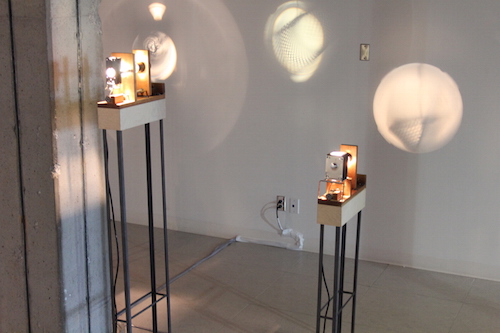
In relationship to media archeology, and the revival of obsolete technology, there is a current movement towards the study and creation of zombie media. Zombie media is interested in the reuse or resurrection of media that has entered into a state of obsolescence. The concept of Zombie media is being used to inform the creation of art that repurposes old technology to create original work, an example is seen here in Layne Hinton’s Shadow Machines, also from Influenc(Ed.) Machines, which are constructed from salvaged obsolete projectors that have been disassembled and repurposed as a work of art. Perhaps the methodology of zombie media can also be used by a curator to reinterpret and revive obsolete works of electronic and new media art? Let’s consider the possibility of an obsolete work of art in the space of a gallery to allow for a reinterpretation and ‘re-originality’ for the non-functioning or revived art object.
Works Cited
Brown, Bill. “Thing Theory”, Critical Inquiry, 28, 1, 2001. 1-22.
Heidegger, Martin. Being and Time, translation by Joan Stambaugh. State University of New York Press, 1996.
Parikka, Jussi. “Zombie Media: Circuit Bending Media Archeology into an Art Method.” Leonardo 45.5 (2012): 424-30. JSTOR. Web.
Many thanks are due to Dr. Caroline Langill and Dr. Lizzie Muller for their principal research into the new media art category of ‘Lively Objects’. Their research, and their curated exhibitions such as Lively Objects (2015) at the Museum of Vancouver, inspired the curation of Influenc(Ed.) Machines and much of my subsequent research in the field of lively and agential new media art objects.
What do you think? Leave a comment.










White is one of those artists who have employed computers in an outstanding way.
Absolutely, of course I am a great fan of his work. A pioneer and self-taught in regards to most of the technologies he uses which is really incredible. Innovation and perhaps a lack of resources in the 1960s and 1970s caused him to create some fascinating and weird work.
Not what I would define as art. Algorithms have predetermined outcomes, it’s still the product of the programmer, like using a camera or photocopier.
Thank you Dayton. I would argue otherwise. Art is always a product of some maker so the fact that these works are programmed by an artist does not negate their value as ‘Art’ nor as entities that appear as actors in an environment of relationships between viewers, spaces and things (here I am thinking of Latour’s Actor-Network-Theory). But of course art is subjective and though robotics and media art more generally are lacking scholarship in the greater art historical canon the medium(s) remain instrumental to contemporary artistic production.
I think they are creative in a manner very similar to human creativity. Its easier to approach this subject with regards to the question of “Are the Robots Creative?” rather than the bigger one of “Is it Art?”
The amount of discarded electronic media is not only the excavation ground for quirky media archaeological interests, but one of the biggest threats for ecology in terms of the various toxins they are leaking back to nature.
Thanks for your comment Minh, I absolutely agree. A lot to be said about the ethics and environmental implications of new media art production. Media archaeology (as both artistic and curatorial practice) may provide an excellent and exciting solution (or repurposing) of the detritus. I think Jussi Parikka is an excellent scholar on the subject.
A truly erudite analysis. Well researched, well written, and discusses a very fascinating subject. Well done.
well done
Well done. Good topic, good writing.
I am so pleased to see this article published. When it was pending, I knew it was something special and different, therefore a wonderful addition to the forum. This article is so rich with knowledge, yet accessible and provides a wonderful amalgam of past and present concepts combining the worlds of philosophy and technology. Wonderfully done!
Thank you so much for your kind words Danielle! I so appreciate your feedback. It it really wonderful to hear that there is an interest in this type of weird and wonderful art work.
Wonderful analysis on an unusual topic. Loved it Treva!
For robots to truly be making art, they would need to be making art relating to their experience as a robot, not mimicking artworks found in kitsch high street galleries.
I used to think that to. But don’t anymore. Guess it comes down to definition of artist and creativity.
If there is an artist here, it is the programmer, not the robot.
Very impressive!
Zombiefication of media… this is my new daily term.
Thanks Denny! I think the phrase conjures up a great visual. Lots of old, worn and decaying media coming to life! So exciting!
With the perspective of the hardware returning to be used in art pieces, likewise there is the chance that the media in the meaning of data resurfaces in the hands of artist or others.
Thought-provoking article. Thank you so much for writing it.
I love Norman. He was my teacher and mentor.
Amazing! He is incredible, such a fascinating guy. I was lucky enough to work with him while curating the exhibition I mentioned.
Not passing judgement on whether it is good or bad or brilliant or not. By definition it can never be called art. The same way a baseball can not be called an orange. One is not better than the other they are just not the same thing. Art is human by definition. AI is not life. It might even be better in many ways but never the same thing. Just because I am a human being and I say so. That is art.
Thanks for your feedback Correa. I don’t think we can make this distinction by comparing a baseball to an orange. As you say yourself art is defined by humans (it is a notion created by the human ontology). The AI is not defining itself as art, but rather, the many scholars, curators and artists who have worked in, commented on and created schools of thought around new media practice have deemed this type of robotic work to be art. I think today our ideas about what constitutes ‘Art’ have really broadened and are continuing to do so.
And yet even that orange had been ‘made’ ,OK, modified ,bred , interfered with, by man .The man will make the bot to do what it can do just as he made the paintbrush and ground pigment with oil. Art can be made with anything – but yes, still not by anyone . It is always gesture that is communicated , you can’t tell me a bot couldn’t make a Walter de Maria or Frank Stella ,Sol le Witt or Joseph Albers or blah blah blah etc for fuck’s sake they can make a car !
What they could NOT do of course is get INSIDE Mondrian and work out how the fuck he tuned into the cosmos !
Anything people make can be art.
Robots can even pretend to be Hippies!
The verb is not “pretend,” it’s “condescend.”
There is a way to go beyond cognitive limits and then to make imagery from that place beyond cognition in ways that humans could see, but not create themselves. Drug experience proves there is a pathway.
but if beyond cognition you wouldn’t know it’s there , sorry .And surely if you are not experiencing everything as one big blob , ie no pathways, you are taking the wrong drugs ?
I test this out on calendar art i.e. how one has cognition of what over a given time. One can have glimpses of ‘higher’ levels of imagery according to advanced cogntion.
Could you cite a source? I’m wonder if the drug experiences – at least some of them – are not, as you say, “beyond cognitive limits,” but cognition confused. Just because we think we’ve experienced something doesn’t mean we have. On the other hand, it also doesn’t necessarily mean our experience was imagined or confused.
Inspiring to these revived through art.
Interesting piece on media culture.
Using AI, where the artistic value can be assessed not by the mechanics, but by both the inspiration and the interpretation.
I wonder if years in the future, when humans are extinct, if AI automatons will debate the nature of their beginnings and whether mankind was their God or creators?
Thank you for your comment. A very interesting and eerie proposition, and this is why I love speculative realism! A great thought experiment.
Media may disappear in a popular sense, but it never dies: it decays, rots, reforms, remixes, and gets historicized, reinterpreted and collected.
Trying to mimic a human’s idea of what art is.
Whether or not its art, it is stunning.
There is always a better camera, laptop, mobile phone on the horizon: new media always becomes old.
Digitally produced art under artificial intelligence would eliminate the physical mess and mechanical complexity.
Humans and AI can recover when a process attempts to divide by a zero.
I would like to attribute the term ‘Lively Objects’ to the research of Dr. Caroline Langill and Dr. Lizzie Muller.
Also, the exhibition Influenc(Ed.) Machines was inspired by the aforementioned research of Dr. Langill and Dr. Muller into the liveliness that characterizes new media art practice and exhibition.
I love the complexity of the work!
Brilliant article. Interesting to consider obsolescence in relation to the ‘archival impulse’ in contemporary art.
Great Article and Very Creative Idea
Zombie media got me.